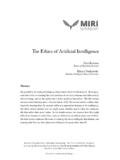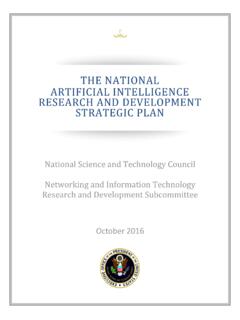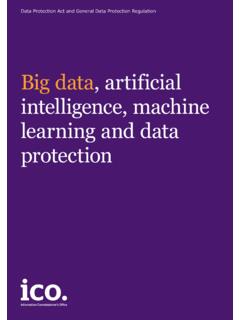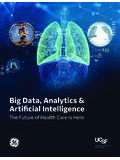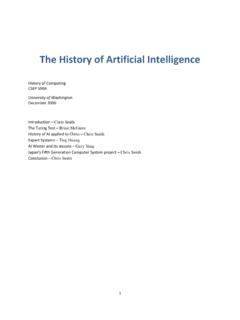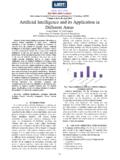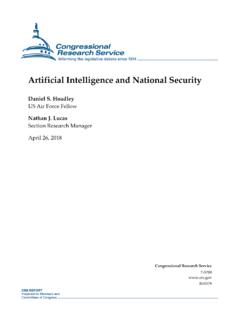Transcription of Machine Learning for Wireless Networks with Artificial ...
1 Machine Learning for Wireless Networks with ArtificialIntelligence: A Tutorial on Neural NetworksMingzhe Chen , Ursula Challita , Walid Saad , Changchuan Yin , and M rouaneDebbah Beijing Laboratory of Advanced Information Network, Beijing University of Posts and Telecommunications,Beijing, China 100876, Email: and School of Informatics, The University of Edinburgh, Edinburgh, UK. Email: Wireless @VT, Bradley Department of Electrical and Computer Engineering, Virginia Tech, Blacksburg, VA,USA, Email: Mathematical and Algorithmic Sciences Lab, Huawei France R & D, Paris, France,Email: Wireless Networks must support ultra-reliable, low-latency communication andintelligently manage a massive number of Internet of Things (IoT) devices in real-time, within a highlydynamic environment.
2 This need for stringent communication quality-of-service (QoS) requirements aswell as mobile edge and core intelligence can only be realized by integrating fundamental notions ofartificial intelligence (AI) and Machine Learning across the Wireless infrastructure and end-user this context, this paper provides a comprehensive tutorial that introduces the main concepts of machinelearning, in general, and artificial neural Networks (ANNs), in particular, and their potential applicationsin Wireless communications. For this purpose, we present a comprehensive overview on a number ofkey types of neural Networks that include feed-forward, recurrent, spiking, and deep neural each type of neural network, we present the basic architecture and training procedure, as well asthe associated challenges and opportunities.
3 Then, we provide an in-depth overview on the variety ofwireless communication problems that can be addressed using ANNs, ranging from communicationusing unmanned aerial vehicles to virtual reality and edge each individual application, wepresent the main motivation for using ANNs along with the associated challenges while also providing adetailed example for a use case scenario and outlining future works that can be addressed using a nutshell, this article constitutes one of the first holistic tutorials on the development of machinelearning techniques tailored to the needs of future Wireless research was supported by the National Science Foundation under Grants CNS-1460316 and [ ] 9 Oct 20172I.
4 INTRODUCTIONThe Wireless networking landscape is undergoing a major revolution. The smartphone-centricnetworks of yesteryears are gradually morphing into a massiveInternet of Things (IoT)ecosys-tem [1] [4] that integrates a heterogeneous mix of Wireless -enabled devices ranging from smart-phones, to drones, connected vehicles, wearables, sensors, and virtual reality apparatus. Thisunprecedented transformation will not only drive an exponential growth in Wireless traffic inthe foreseeable future, but it will also lead to the emergence of new and untested wirelessservice use cases, that substantially differ from conventional multimedia or voice-based instance, beyond the need for high data rates which has been the main driver of thewireless network evolution in the past decade next-generation Wireless Networks must beable to deliver ultra-reliable.
5 Low-latency communication [5] [8], that is adaptive, in real-timeto a rich and dynamic IoT environment. For example, drones and connected vehicles [9] [12]will place autonomy at the heart of the IoT. This, in turn, will necessitate the deployment ofultra-reliable Wireless links that can provide real-time, low-latency control for such autonomoussystems. Meanwhile, in tomorrow s Wireless Networks , large volumes of data must be collected,periodically and in real-time, across a massive number of sensing and wearable devices.
6 Suchmassive short-packet transmissions will lead to a substantial traffic over the Wireless uplink, whichhas traditionally been much less congested than the downlink. This same Wireless network mustalso support cloud-based gaming [13], immersive virtual reality services, real-time HD streaming,and conventional multimedia services. This ultimately creates a radically different networkingenvironment whose novel applications and their diverse quality-of-service (QoS) and reliabilityrequirements mandate a fundamental change in the way in which Wireless Networks are modeled,analyzed, designed, and need to cope with this ongoing and rapid evolution of Wireless services has led tomuch research that investigates what the optimal cellular network architecture will be within thecontext of the emerging fifth generation (5G)
7 Wireless Networks ( , see [14] and referencestherein). While the main ingredients for 5G such as dense small cell deployments, millimeterwave (mmWave) communications, and device-to-device (D2D) communications have beenidentified, integrating them into a truly harmonious Wireless system that can meet the IoTchallenges requires instillingintelligent functions across both the edge and core of the intelligent functions must be able to adaptively exploit the Wireless system resourcesand generated data, in order to optimize network operation and guarantee, in real-time, the QoSneeds of emerging Wireless and IoT services.
8 Such mobile edge and core intelligence can only berealized by integrating fundamental notions ofartificial intelligence (AI)[15] across the wirelessinfrastructure and end-user the notion of artificial intelligence can be traced back to the mythological Greek bronzeman Talos [16] an artificially intelligent man- Machine created to protect the island of Crete frominvaders, its true potential has only been recently realized owing to the substantial developmentsinmachine Learning [17], in general, andneural Networks [18], in particular.
9 Indeed, machinelearning tools are undoubtedly the primary vessel that is carrying artificial intelligence to fruitionacross a myriad of applications [19] [26] that range from computer vision to natural languageprocessing, robotics, and autonomous systems. As such, creating AI-enabled Wireless networksis contingent upon developing the right set of Machine Learning and neural network tools thatcan provide the plethora of AI functions needed in future Wireless Networks to unleash the truepotential of the IoT. Such tools must naturally be tailored to the unique features of the wirelessenvironment, which is evidently quite different from the traditional applications of AI, such asin robotics and computer vision [27] [30].
10 For instance, artificial intelligence is expected to play several roles in the next-generationof Wireless Networks [31]. First, the most natural application of AI and Machine Learning is toexploitbig data analyticsto enhance situational awareness and overall network operation. In thiscontext, AI will provide the Wireless network with the ability to parse through massive amountsof data, generated from multiple sources that range from Wireless channel measurements andsensor readings to drones and surveillance images, in order to create a comprehensive operationalmap of the massive number of devices within the network.

![arXiv:0706.3639v1 [cs.AI] 25 Jun 2007](/cache/preview/4/1/3/9/3/1/4/b/thumb-4139314b93ef86b7b4c2d05ebcc88e46.jpg)

![arXiv:1301.3781v3 [cs.CL] 7 Sep 2013](/cache/preview/4/d/5/0/4/3/4/0/thumb-4d504340120163c0bdf3f4678d8d217f.jpg)
![@google.com arXiv:1609.03499v2 [cs.SD] 19 Sep 2016](/cache/preview/c/3/4/9/4/6/9/b/thumb-c349469b499107d21e221f2ac908f8b2.jpg)





